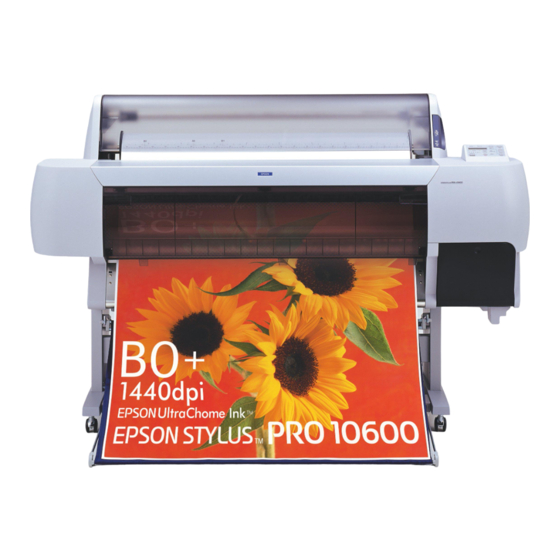Epson 10600 - Stylus Pro Color Inkjet Printer Snelle referentie - Pagina 5
Blader online of download pdf Snelle referentie voor {categorie_naam} Epson 10600 - Stylus Pro Color Inkjet Printer. Epson 10600 - Stylus Pro Color Inkjet Printer 10 pagina's. Product brochure - efi fieryspark professional 2.0 rip
Ook voor Epson 10600 - Stylus Pro Color Inkjet Printer: Specificatieblad (8 pagina's), Snelle installatiehandleiding (34 pagina's), Specificaties (4 pagina's)

Aligning the Print Head
Aligning the Print Head
If banding appears on your prints, or vertical lines are not
straight, you may need to align the print head. Before you
begin, print a nozzle check (see page 4) to ensure that the
problem is not caused by clogged nozzles.
1
Make sure the printer is turned on and 44-inch wide
paper is loaded. (Be sure to use coated ink jet paper,
such as the Doubleweight Matte Paper that came with
the printer. For best results, use the paper you'll be
printing on to perform the alignment.)
2
Press the
button until
SelecType
ALIGNMENT MENU
3
Press the
button.
Item
on the display.
If you are using EPSON paper, leave this setting
on
.
STD
If you are using other media, enter the thickness value
of the paper in 0.1-mm increments by pressing the
or
button. Check the media specifications for
+
–
its thickness.
4
Press the
button. You see
Enter
on the display.
LC
5
Press the
button so that
+
appears.
6
Press the
button to print the alignment pattern.
Enter
7
Examine the first row (marked
of patterns similar to the one below across the width
of the paper. Use your own eye loupe or the one that
came with the printer to determine which line is the
best. (Each line is composed of two overlapping
colors. Look for the line in which the colors overlap
the most evenly.) In the example below, #8 is the best
choice.
number 8 shows the best line
HEAD
is displayed.
appears
PAPER THICK=STD
ALIGNMENT=Bi-D
ALIGNMENT=Uni-D
). You see a series
#1 C
8
Look at the other patterns in the first row to see if the
same number is consistently the best line. If not,
determine which number is generally the best.
Ideally, number 8 (±1) should be the best line in
all of the printed patterns. If it is, you can press
Pause to exit the adjustment early.
9
Check the control panel display. It shows
which means that number 8 is the current setting for
row
. If you need to change the setting, use the
#1 C
or
button to select the best line for that row. Then
–
press the
button to register the setting.
Enter
10
Repeat steps 7 through 9 for each additional row.
11
When done, press the
alignment.
You may have to repeat the adjustment more than
once to ensure that number 8 is the best choice in
all cases.
12
When done performing the adjustment in Uni-D
(uni-directional) mode, as described above, you
should repeat it in Bi-D mode (select
). The process is exactly the same, but the
= Bi-D ALL
printed pattern is different:
number 8 shows the best block
To select the best pattern, use an eye loupe to determine
which block has the smallest gaps. In the example above,
number 8 has the smallest gaps.
5
,
#1 C=8
button to exit the head
Pause
ALIGNMENT
+
